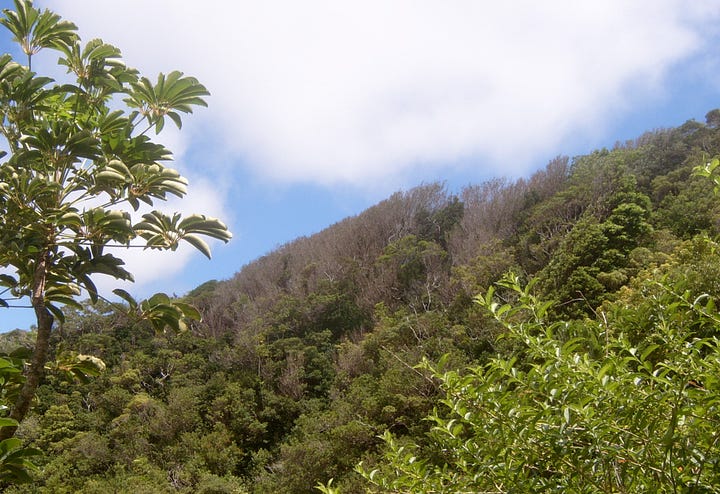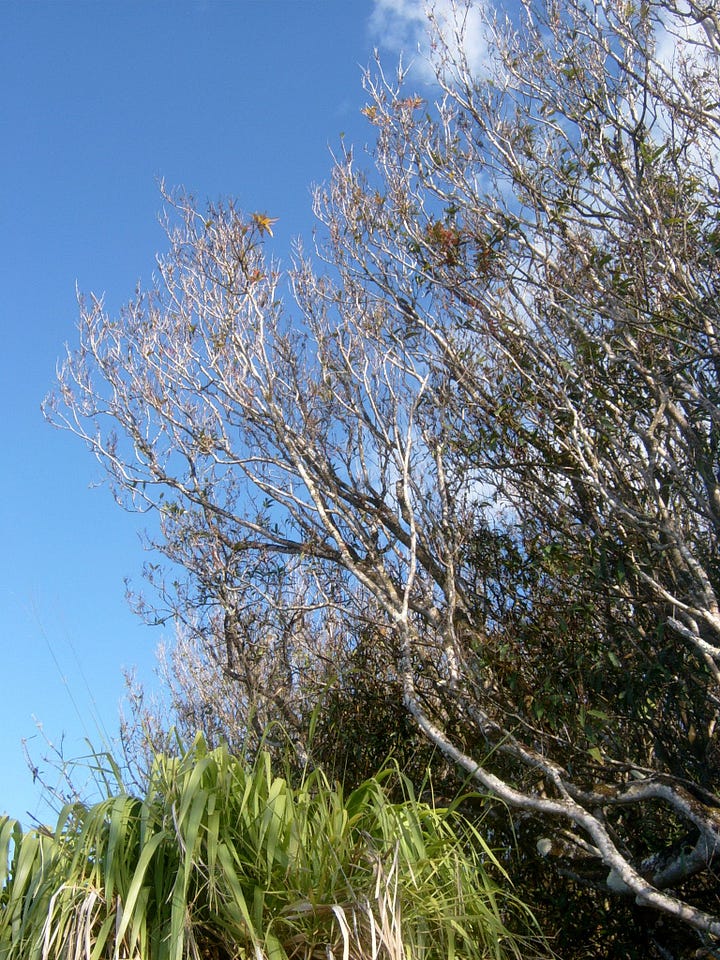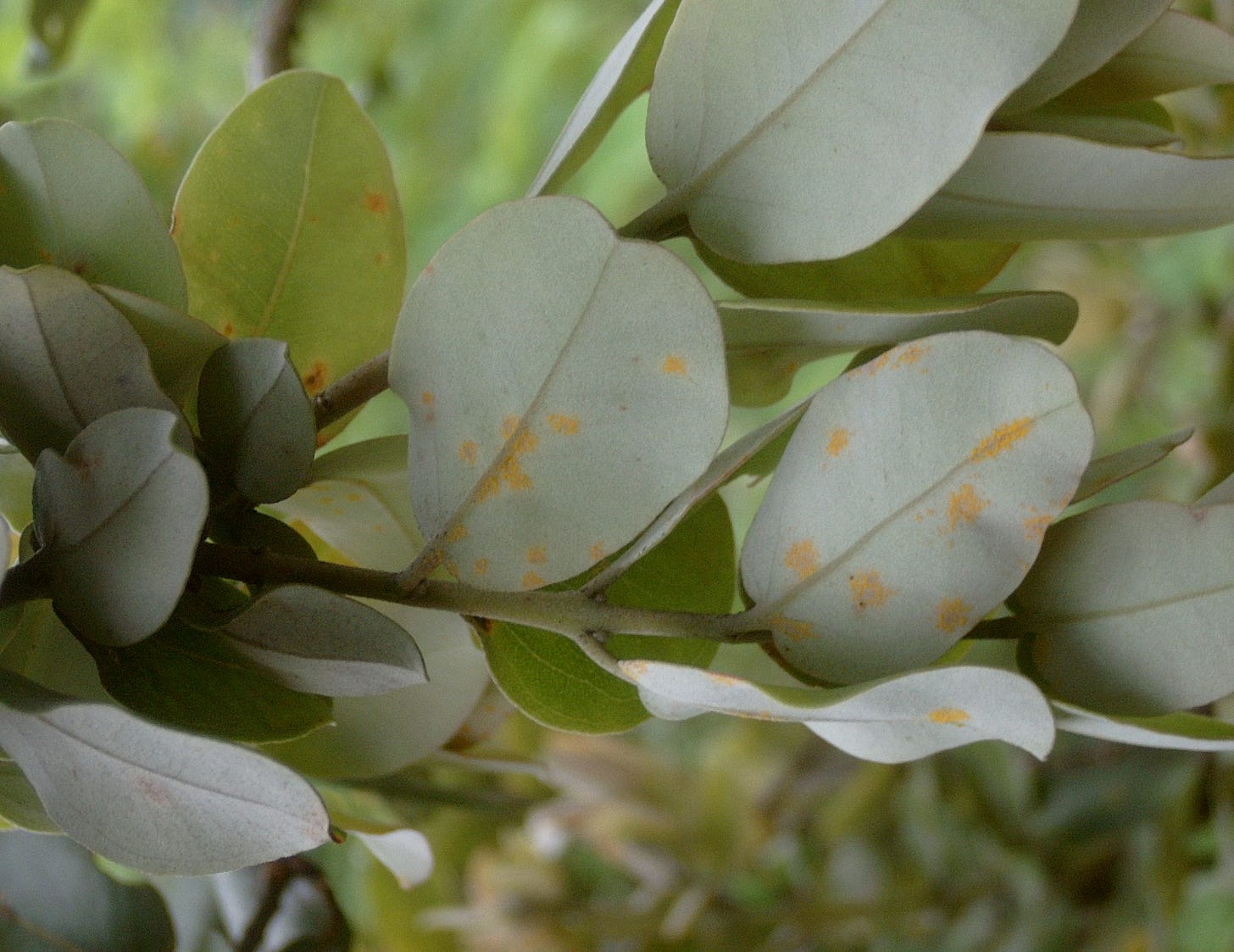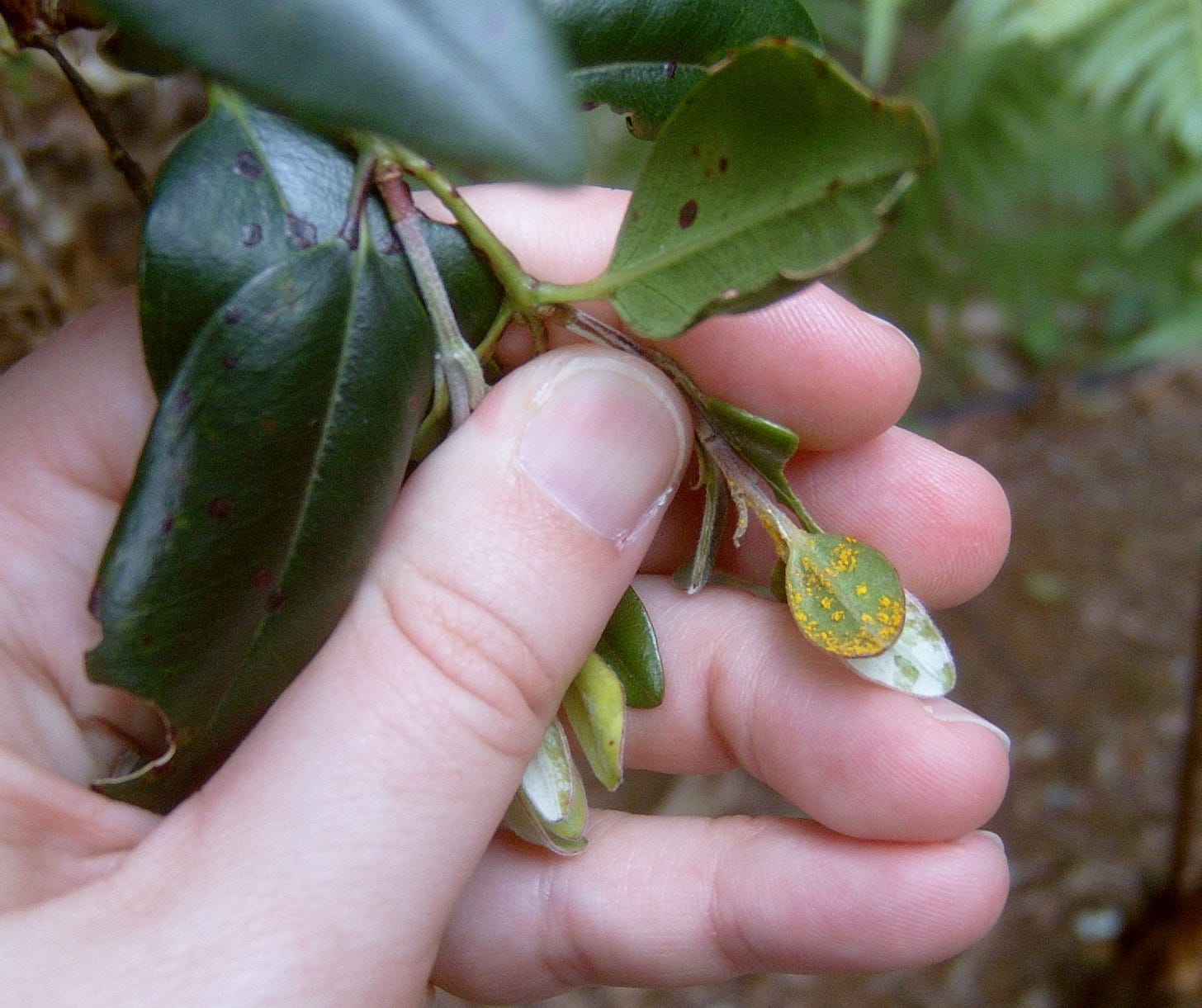Rust never sleeps
The insidious threat to Australia's, and New Zealand's, iconic trees (11 minute read)
For as far as I can see, the Blue Mountains are blanketed in gum trees. The most distant hills are somewhat blue, I suppose, but most of the forest is more of a mottled khaki green. The only variations are the darker green where deep chasms have been carved into the rock by water which has flowed there for millions of years and the red-brown cliffs of Mount Solitary.
From where I’m standing at the top of an escarpment, I could believe that all the trees were the same, although I know they aren’t. Even in the limited areas where I’ve walked, I’ve probably seen at least half a dozen different types of gum trees. They cast only a light shade, and there’s a dense, diverse undergrowth too. In the deep chasms, the canopy of gum trees is replaced by rainforest trees with an undergrowth of ferns. On the most exposed ridges, there’s shrubland rather than forest. In a few places, the ground is saturated and swamp plants grow.
But with my botanist’s eyes, there’s something I’m noticing everywhere I look. Last week, I wrote about how botanists classify plants into families. It’s a useful skill to learn how to recognise some of these families – it means that I can go somewhere I’ve never been before and make an educated guess on some of the plants. But these families are more than just an aid to identification. Other living things, such as certain insects, recognise them as well.
When I wrote about botanical families last week, I forgot to mention one of the most familiar examples of this situation. If you’ve ever grown a swan plant, you’ve probably had the beautiful yellow, black and white monarch caterpillars feeding on it. Often, there are far too many caterpillars and the swan plant is eaten until it’s nothing but twigs. The starving caterpillars will roam your garden and not touch anything else, unless, that is, you offer them a plant belonging to the same botanical family1.
What my botanist’s eye notices in the Blue Mountains (and, in fact, everywhere I look in Australia) is a family called the myrtle family. Botanists call it the Myrtaceae, and it’s named after a shrub native to the Mediterranean, western Asia and into parts of India. Although named after a Northern Hemisphere species, the myrtle family is almost entirely a Southern Hemisphere and equatorial family. Around 1700 species are native to Australia, around 30% of the total number worldwide.
Australia’s ubiquitous gum trees belong to the myrtle family. Beneath the gum tree canopy, there are many shrubs from the family as well. In Australia’s wetlands there are swamp paperbarks, also from the myrtle family. Areas of rainforest have a diverse range of species from different families, but many of the trees are from the myrtle family too.
Do you know the saying don’t put all your eggs in one basket? If Australia’s trees were eggs, then almost all of them would indeed be in one basket. With so many types of tree from a single botanical family, Australia is uniquely vulnerable if there happens to be a pest or disease which affects that family.
In the late 1930s and early 1940s, when the world was focused on other problems, Brazilian scientists began noticing sick gum tree seedlings. These were lemon-scented gums, a species native to eastern parts of Queensland, which is widely planted in Australia and around the world. At first, spots appeared on the leaves, then the spots erupted with yellow powder – the characteristic sign of a type of fungus known as a rust. Eventually, the seedlings suffered considerable damage, with leaves deformed or dying back.
Rust fungi are parasitic fungi which cause diseases in plants. They aren’t the type of fungus you’ll find sprouting mushrooms in a field – they can survive only in living tissue of their host plants. They get their name because in some rusts the spores (which are like seeds for fungi) are reddish brown. A wheat plant infected by stem rust looks as if its stems have turned rusty (wheat stem rust also has a bizarrely complicated life cycle, if you are interested, there’s a great video explaining it here).
A curious quirk of rust fungi is that almost all of them are very fussy about which plants they infect. Most infect only one or two closely-related species. But the rust disease infecting the lemon-scented gums was unusual. The scientists identified it as a species which also infected guava, rose-apples, allspice and Australian paperbarks cultivated in the gardens of a Brazilian agricultural institute. All of these plants belonged to the same family, the myrtle family, but within that family they belonged to distinct groups (known as genera). Now the fungus had jumped onto gum trees, still in the same family, but a different genus again.
At the time, the rust infecting the lemon-scented gum was found in parts of South America and the Caribbean. Over the next few decades, that was where it stayed. It continued to affect plantation gum trees, eventually become recognised as a serious problem in some areas of Brazil. Occasionally, it was reported infecting another plant species – always in the myrtle family. It acquired various common names, depending on the interests of whoever was talking about it. Australians often called it eucalytus rust, since it infected some gum trees (eucalypts), but the most commonly used name was guava rust.
In 1979, it was found in Florida, but even then, as far as I can tell, there wasn’t much alarm. Brazilian scientists continued to work on it, finding it infected other types of gum tree. When, in the 1990s, it infected Australian paperbarks which were invading the Florida Everglades, scientists discussed the possibility that it could be used for biological control.
By this time, Australians were becoming concerned. During the 1980s, they restricted the import of material of plants which were known hosts. In the late 1990s, they took a closer look at where the rust was known to occur and assessed which parts of Australia could be affected. Mostly, it appeared to be a risk in coastal Queensland, as well as a few areas in north-eastern New South Wales and the Northern Territory. Many, many species in the myrtle family grew in these areas.
New Zealand also took notice. We grow gum trees commercially, and although we don’t grow a lot, they produce high value timber. A single gum tree is worth much more than a single pine. We also have more than 30 native species in the myrtle family. That’s not many compared to Australia, but the myrtle family in New Zealand includes treasured species, such as pōhutukawa, rātā and mānuka. At some point we banned the import of any known guava rust host from places where it was found. I don’t know exactly when this was, all I know is that it was definitely before 2005, when I first checked the regulations.
I joined New Zealand’s Ministry for Agriculture and Forestry (as it was known then) in March of 2005. A month later, for the first time, I heard of what was then being called guava rust. It had been found in Hawai’i, and it wasn’t infecting a guava or a gum tree or any other species it had infected before. It was infecting ‘ohi’a, one of the most important native trees in Hawai’i.
Australian scientists were very worried indeed. Suddenly, the rust was a whole lot closer to their shores. But it was also closer to New Zealand. And we were worried too, because ‘ohi’a is a close cousin of pōhutukawa.
I don’t know exactly what Australia did in response to guava rust arriving in Hawai’i, because much of the response to a situation like that happens behind the scenes. However, I do know some of what New Zealand did, because I was involved when I was working in biosecurity. It wasn’t secret or particularly contentious, but it doesn’t feel entirely appropriate for me to write articles about work I did as a public servant. However, at least some of it was either public information at the time or later, so I’ve decided that I can write about that.
Because New Zealand already prohibited the import of host plants from areas with guava rust, one action was obvious. We added the Hawai’ian ‘ohi’a to the list of host plants, and banned any import of host plants from Hawai’i. In effect, though, the ban was slightly wider than ‘ohi’a. In most cases, rules for importing plants are not set at the level of individual plant species. New Zealand typically uses the next classification level, known as the genus. Hawai’ian ‘ohi’a belongs to the same genus as pōhutukawa, all species of rātā and various others which are mostly from the Pacific Islands and New Guinea.
We also kept in touch with Hawai’ian and Australian researchers, so we could learn more about the risk to New Zealand. Fortunately, over the next few years it turned out that only a small proportion of ‘ohi’a plants were infected, and on those that were, the damage wasn’t too severe. There were also a few New Zealand pōhutukawa cultivated in Hawai’i. Some of these were infected, but, like ‘ohi’a, they weren’t badly damaged.
However, the same could not be said for the endangered shrub known as nioi. Scientists estimated that only around 100 adult plants remained prior to the arrival of the rust. Almost all of these became infected and some were killed by the rust. Although the species is still hanging on, the rust has been a severe blow to the survival of nioi.
The most seriously affected plant in Hawai’i, though, was the rose-apple – an invasive species there. In some places, large areas of this tree died off, in a case of an invasive species killing an invasive species. At first glance, this may seem cause for celebration, but the death of rose-apple didn’t mean that native species would come back, as there were so many other invasive plants. And it was clear proof that guava rust was capable of causing major damage in wild forests, not just plantations and gardens.


That still left questions, though. Hawai’i is tropical, and the New Zealand pōhutukawa cultivated there were growing well outside their normal conditions. How would the guava rust cope with New Zealand’s climate? Would our plants be saved by the cold?
Unfortunately, there was no way to answer this question for sure. Until a pest or disease arrives in a new area, there is always uncertainty about how it will behave. But we can look at the places where they are found overseas and compare their climates to New Zealand’s.
Before guava rust arrived in Hawai’i, it looked as if it would find most of New Zealand too cold. But there were worrying signs in Hawai’i. While the islands sit within the tropics, two of its islands have high mountains at their centres. Haleakalā, on Maui, is more than 3000 metres high, similar to Tititea/ Mt Aspiring in New Zealand’s Southern Alps. Mauna Kea, on the island of Hawai’i, is over 4000 metres, making it significantly higher than New Zealand’s highest mountain, Aoraki/ Mt Cook. As you move up these mountains, it gets cooler, so much so that they can have snow.
From what we heard from scientists in Hawai’i, guava rust had moved much further up the Hawai’ian mountains than could have been predicted based on where it had been found in South America and the Caribbean. We arranged for some scientists to look more closely at this, matching different places in Hawai’i with the climate in New Zealand. They found that the rust was likely to survive in much more of New Zealand than had previously been thought.
Although I know that Australia, like New Zealand, had strict rules to try and prevent the rust from arriving, ultimately their effors failed. In April 2010, guava rust was found in a plant nursery near the New South Wales coast. Although there were attempts to contain and eradicate it, the rust was detected too late, and even if it had been detected earlier, it’s debatable whether anything could have been done. At the time, there was only one known eradication of a rust, and that had been infecting only a few plants in a glasshouse. I’ve done further searching, and can find no evidence that there have been any successful eradications since then. Rusts produce huge quantities of dust-like spores, which can travel vast distances on the wind. They are very difficult diseases to contain.
The arrival in Australia was bad news for New Zealand too. Prior to the arrival of guava rust, five other rust species had arrived in Australia and then been found in New Zealand very soon after. Most took less than two years to get here, almost certainly because they were blown across the Tasman Sea by the prevailing westerly wind. The most recent had arrived in 2005. Of those rusts in Australia with host plants in New Zealand, only one hadn’t made it across.
The people who worked in my area were pessimistic about New Zealand’s chances of keeping guava rust out. However, we did change the import rules to try and delay it for as long as possible. This time, we didn’t prohibit only known hosts. We prohibited all members of the myrtle family from all areas known to have the rust. It was clear, from what was happening in Australia, that predicting which species would be infected was almost impossible – as long as they belonged to the myrtle family, they were in danger.
To be continued…
Next week, I’ll write about what the rust has done in Australia and New Zealand, as well as looking at research into how we save our affected plants and how climate change might affect the disease.
When I was a child, I was told they would eat pumpkin, and so I tried that. They’ll eat if if they are desperate, but mostly they won’t survive.






I always find your thoughts observations and writing fascinating. We have been in Puglia in the south of the heel of Italy. ALL the olive trees are dead- some 100s years old. This was Italys biggest oil producing area!
This account is not scientific but based on conversations with locals.
The cause is said to be a bacteria carried by a red ant. It came to Italy from a decorative tree imported through Holland. The disease is spreading northwards for up to 100 kms.
They are trialling planting what is hoped to be disease resistant species.
It’s awful to see. What was a whole landscape of green olive groves is now field after field of grey dead trees.
The point I want to make is that the areas with no disease don’t seem to be acting seriously now to try and prevent spread.
It reminds me of visiting my parents around 2000 in Manapouri. My Dad pointed out pristine Fiordland rivers that were brown and gluey with didymo. Returning to Taupo I felt frustrated that the strictest measures were slow to be put in place. If your river is ok in Taupo, and you haven’t seen the mess in Fiordland, there is no impetus to act.
I know that is human nature, and how funding protocols work. Hope for the best and leave problem solving to the last minute.
Thank goodness we had people like you taking it seriously Melanie.
I saw a lillipilli hedge with obvious rust in Auckland several years ago, and reported it. I was assured the property owners would be contacted with instructions to…? Whatever exactly they did or didn’t do, still there, still obviously rusty.